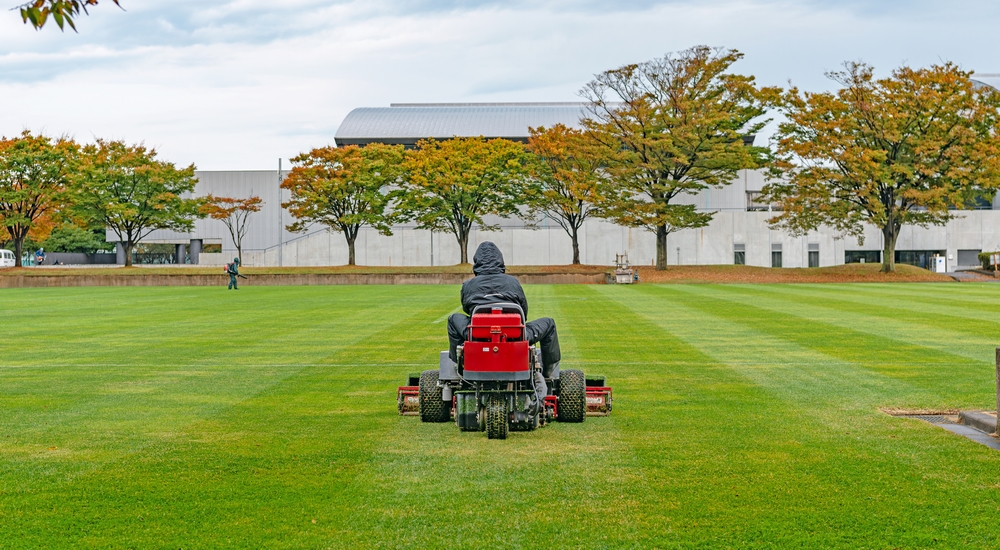The basics of an eco-friendly natural sports field maintenance
By adopting these few simple rules, sustainable sports ground maintenance is childsplay!

During Paysalia 2019, the SFG (the French Grass Professionals Trade association) led a conference on natural sports grounds management. In addition to the importance of the choice of the most suitable grasses that we addressed in this article, an essential factor in successful planting was maintenance of a sports field. Performing a balancing act between an eco-friendly policy and good quality playing conditions on a sports turf is a brain-teaser for public authorities. Fortunately, by adopting a few simple rules, eco-friendly sports ground maintenance is childsplay!

Rule 1: Optimize sowings on your sports turf
Leave the grass enough time to root and settle before playing on it! As far as possible, sow as long as possible before play resumes and avoid conditions likely to stress the grasses (unfavorable weather, presence of diseases or insects), and remember that well-sown grasses resist fungi better. To limit natural meadow grass, fertilize, if necessary, a week after sowing rather than a week before.
The soil should neither be too wet nor too compact. To optimize grass growth, you can use FCSM (fertilizers and crop support materials) approved wetting agents.
If you are re-sowing an existing pitch, it is better to sow small quantities several times (3 x 12-15 gr. for example) than a bigger quantity once!
Lost in sports field maintenance technical vocabulary?
Check our glossary!
Rule 2: Improve air and water circulation in your sports ground
Did you know that 95% of natural sports grounds are overwatered in summer? Many public authorities make the error of calculating water volume as watering time and not in milligrams - the surest to catch diseases! Since grasses in good health require less plant health care chemicals, the way you water must depend on the playing field’s properties.
You will need to carry out a soil analysis and determine the AWC – Available Water Capacity — of your sports field. The term availability involves two notions: (a) the ability of a plant root to absorb and use the water with which it is in contact and (b) the readiness or velocity with which the soil water moves in to replace that which has been used by the plant.
To limit moisture, several solutions are possible and can be combined according to your needs:
- Water your sports turf after 5.00 a.m., especially in summer, and limit the number of times you water.
- Remove surface stresses with wetting agents (preferable once a disease has already broken out or during periods of high pressure).
- Dry grass leaves with iron fertilizer (in autumn or winter) or ventilators (for elite natural sports grounds).
- Use porous ceramic substrates or top dressings of powdered carbons (30 g/sq.m.).
- Adjust mowing height to promote air circulation near the ground. Let the grass grow during the summer to nourish the roots – unless the grass has been attacked by leaf blast!
To maximize air circulation in your sports turf, defelting, sanding and soil restructuring bacteria will be precious allies. Techniques enhanced by standard farming tools like spades, pickaxes and hoes!
Rule 3: Grow rigid, resistant, plant cells for a better playing field
Add enough nitrogen over time, either in several dressings or using fertilizer with a very slow release rate. If you add too much, your grass can overeat: obesity softens the cell walls which makes them much more prone to disease!
There are two “must” ingredients:
- Calcium, which stiffens cell walls and increases resistance to heat.
- Silica, which is a biostimulant, improves the physical barrier role of the leaf cuticle and contributes to collecting light.
Rule 4: Limit a natural sports ground’s electro-conductivity
Urea, the only form of nitrogen which can penetrate leaves, also generates a temporary increase in soil conductivity and pH. This can lead to burns and block trace elements which need a lower pH to be assimilated.
Sulfur and phosphorus should not be used to excess as you run the risk of “over concentrating” the soil, leading to a slow-down of ground-plant osmosis, preventing the grasses from getting sufficient essential nutrients!
This rule is even more important if your substrates have a low CEC (Cation Exchange Capacity).
Rule 5: Augment the resistance and density of the grass
Adding amino-acids and peptides (instead of letting the grasses produce them themselves from nutrients) gives plants more energy without excessive growth.
Trace element complexes enhance grass density. The best method is to apply them one week before a major ventilation campaign or when preparing the sports field with a dressing rich in nitrogen, phosphorus and potassium (aka “NPK”).
Rule 6: Support ground-plant exchanges and ground life
Called the rhizosphere, the first few centimeters of soil houses 90% of its biological activity. These micro-organisms nourish the grasses and it is essential to conserve this source by including it in the sports field maintenance program!
Either use FCSM products, which help nourish and/or strengthen the plants, or phytopharmacological products which protect the grasses from diseases. Other products beneficial to the soil include inert yeasts and vegetable and animal organic materials.
Last but not least, it is vital to contain felting on playing fields. Failure to do so may encourage growth-hindering fungi and/or prevent the grasses from taking root!
To understand the microcosm of a natural sports ground better, think of a fridge!
- A refrigerator is a container like the soil or the substrate where you store water and food.
- The electrical socket is the organic matter - humic and fulvic acids and micro-organisms which provide the power.
- The food stored is NPK + trace elements: they are more easily available if the “refrigerator” is plugged in.
- Last but not least, people who come to get something from the refrigerator act like grasses looking for food. To satisfy their hunger, the refrigerator must be plugged in and easy to open!
By following these rules passed on by the SFG, public authorities can drastically reduce their use of synthetic chemical plant health care products in natural sports field maintenance - a change of approach essential in minimizing the impact of people on the environment! To learn more about sports field management, check our dedicated news section.
* Pyraculiosis: disease caused by a killer fungus - Pyricularia grisea
© Photo credit: mtaira / stock.adobe.com

